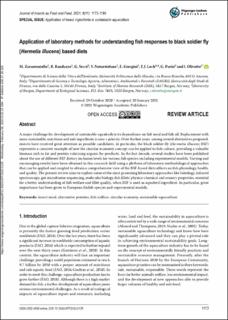| dc.contributor.author | Zarantoniello, Matteo | |
| dc.contributor.author | Randazzo, Basilio | |
| dc.contributor.author | Secci, Giulia | |
| dc.contributor.author | Notarstefano, Valentina | |
| dc.contributor.author | Giorgini, Elisabetta | |
| dc.contributor.author | Lock, Erik Jan Robert | |
| dc.contributor.author | Parisi, Giuliana | |
| dc.contributor.author | Olivotto, Ike | |
| dc.date.accessioned | 2023-02-28T08:29:46Z | |
| dc.date.available | 2023-02-28T08:29:46Z | |
| dc.date.created | 2022-11-24T20:02:17Z | |
| dc.date.issued | 2022 | |
| dc.identifier.issn | 2352-4588 | |
| dc.identifier.uri | https://hdl.handle.net/11250/3054508 | |
| dc.description.abstract | A major challenge for development of sustainable aquafeeds is its dependence on fish meal and fish oil. Replacement with more sustainable, nutritious and safe ingredients is now a priority. Over the last years, among several alternatives proposed, insects have received great attention as possible candidates. In particular, the black soldier fly (Hermetia illucens; BSF) represents a concrete example of how the circular economy concept can be applied to fish culture, providing a valuable biomass rich in fat and protein valorising organic by-products. In the last decade, several studies have been published about the use of different BSF dietary inclusion levels for various fish species including experimental models. Varying and encouraging results have been obtained in this research field using a plethora of laboratory methodological approaches that can be applied and coupled to obtain a comprehensive view of the BSF-based diets effects on fish physiology, health, and quality. The present review aims to explore some of the most promising laboratory approaches like histology, infrared spectroscopy, gut microbiome sequencing, molecular biology, fish fillets’ physico-chemical and sensory properties, essential for a better understanding of fish welfare and fillet quality, when BSF is used as aquafeed ingredient. In particular, great importance has been given to European finfish species and experimental models. | en_US |
| dc.language.iso | eng | en_US |
| dc.publisher | Wageningen Academic Publishers | en_US |
| dc.rights | Navngivelse-Ikkekommersiell-DelPåSammeVilkår 4.0 Internasjonal | * |
| dc.rights.uri | http://creativecommons.org/licenses/by-nc-sa/4.0/deed.no | * |
| dc.title | Application of laboratory methods for understanding fish responses to black soldier fly (Hermetia illucens) based diets | en_US |
| dc.type | Journal article | en_US |
| dc.type | Peer reviewed | en_US |
| dc.description.version | publishedVersion | en_US |
| dc.rights.holder | Copyright 2021 Wageningen Academic Publishers | en_US |
| cristin.ispublished | true | |
| cristin.fulltext | original | |
| cristin.qualitycode | 1 | |
| dc.identifier.doi | 10.3920/JIFF2020.0135 | |
| dc.identifier.cristin | 2080511 | |
| dc.source.journal | Journal of Insects as Food and Feed | en_US |
| dc.source.pagenumber | 1173-1195 | en_US |
| dc.identifier.citation | Journal of Insects as Food and Feed. 2022, 8 (11), 1173-1195. | en_US |
| dc.source.volume | 8 | en_US |
| dc.source.issue | 11 | en_US |

